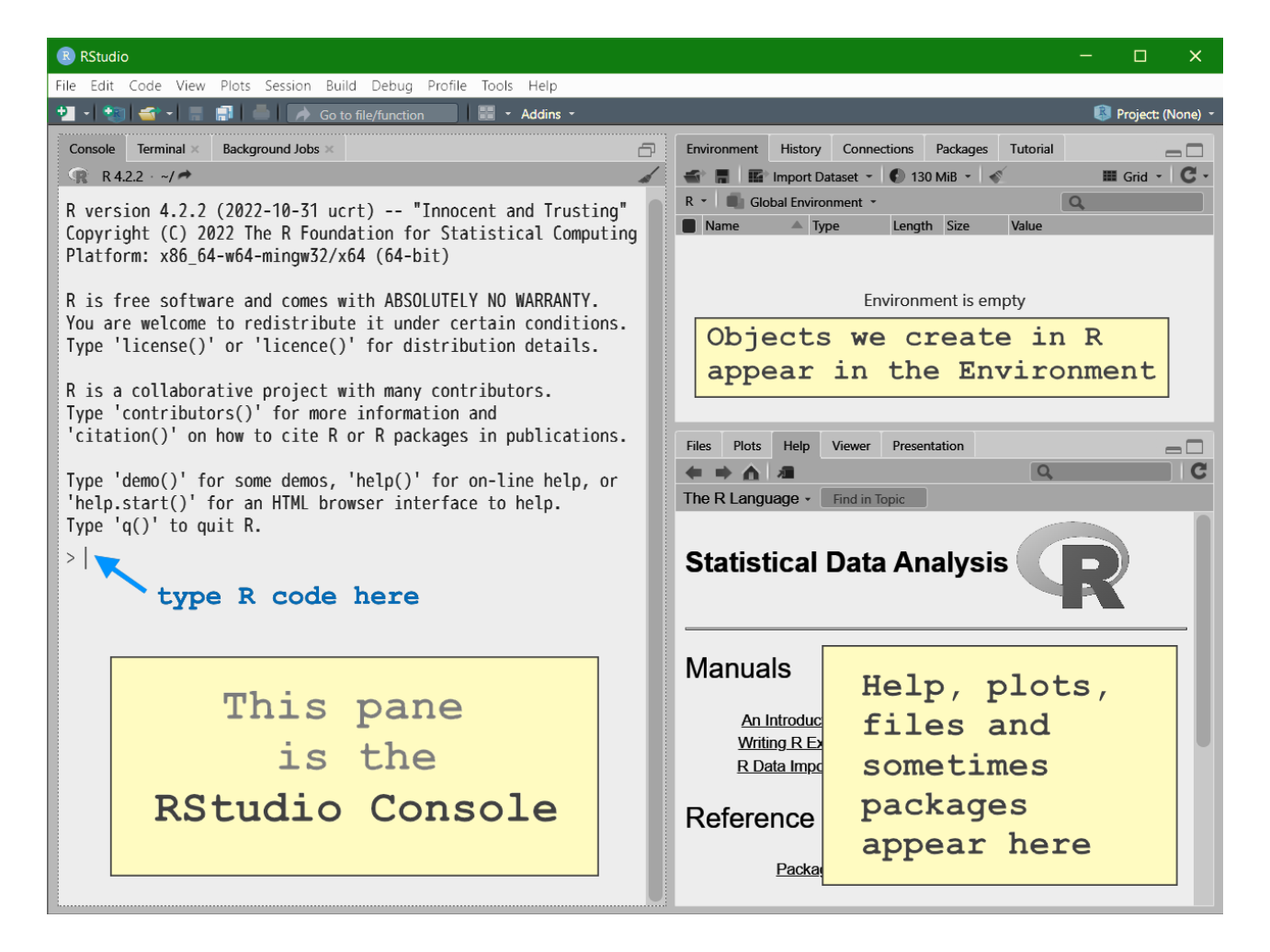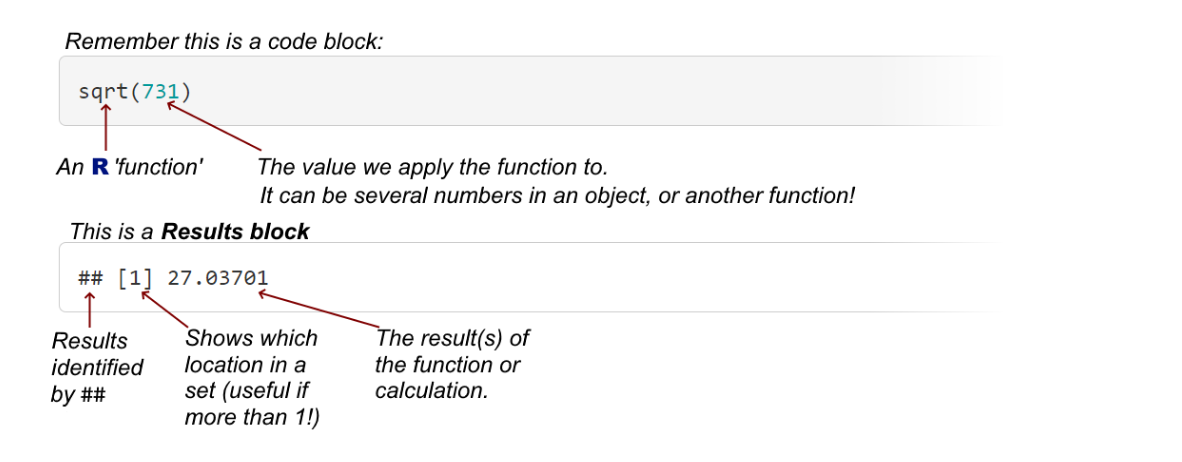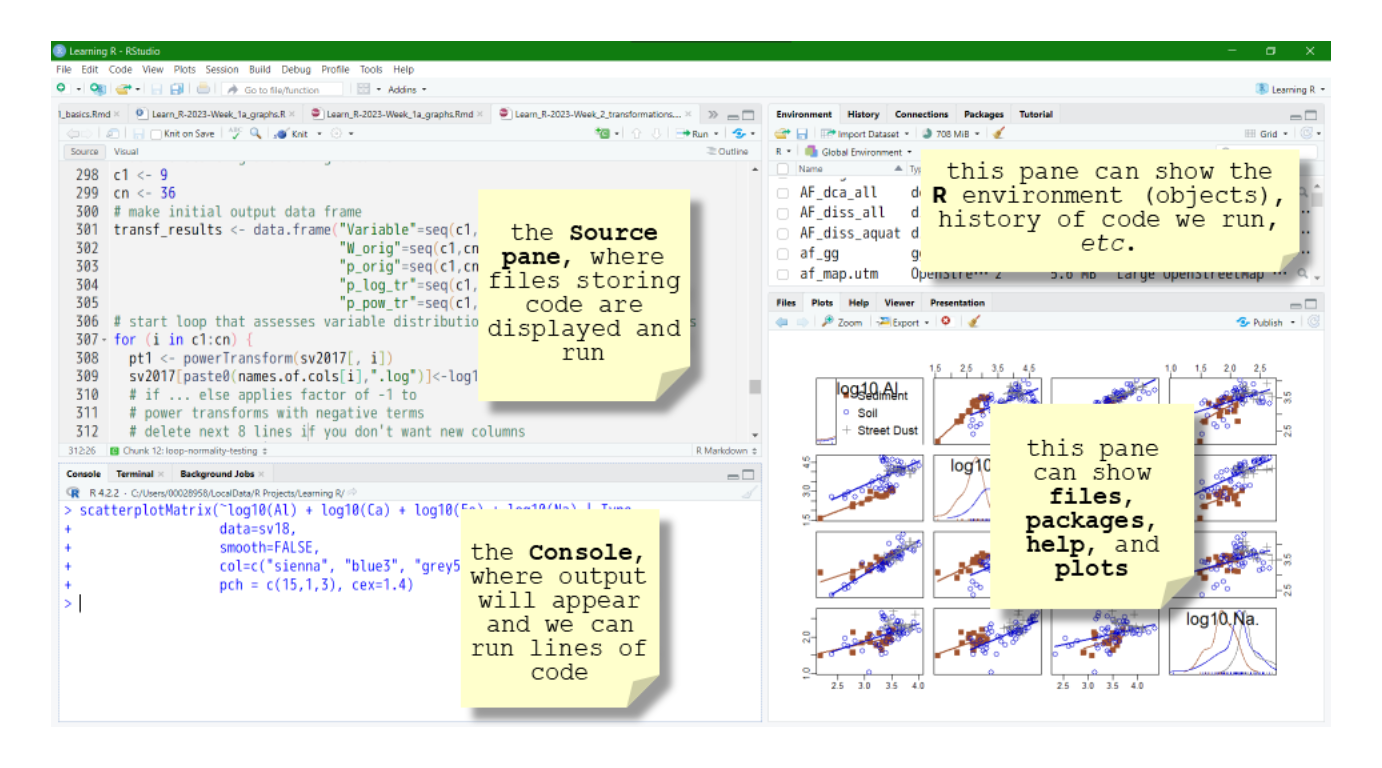 Material to support teaching in Environmental Science at The University of Western Australia
Material to support teaching in Environmental Science at The University of Western Australia
Units ENVT3361, ENVT4461, and ENVT5503
RStudio for absolute beginners
...or maybe just as a reminder
Andrew Rate
2025-12-01
What is R?
R is called a "statistical computing environment". This means two things:
- R is software that allows us to perform statistical analysis of data;
- R is a type of computer programming code (a language).
In R these two features are combined so that we perform the tasks we need to by writing instructions in R code. We commonly want to:
- create or input data
- format, store, and save our data
- perform statistical and numerical analysis of our data
- display our data and report our analysis in graphs and tables
By using R code to do this, we can easily reproduce our analyses, that is, use exactly the same procedures again on additional data, or simply re-create what we have done. We can save our R code in simple 'text' files, or even in a document called an R Notebook which uses a few additional coding features (called 'R markdown') to let us save our code and the results of our analysis in the same document. We use R markdown to produce documents such as reports (this document is created using R markdown).
"...R has developed into a powerful and much used open source tool ... for advanced statistical data analysis..."
— Reimann et al. (2008) – Statistical Data Analysis Explained: Applied Environmental Statistics with R, p.3.
R and RStudio
To make our job of using R easier, we'll be using the RStudio program. RStudio is an IDE or 'integrated development environment' which puts everything we need for R coding in one place, and has some helpful tools (such as predictive text for code, and some menu-driven functions) to make coding easier. In this document, when we say 'R', we really mean 'R in the RStudio environment'.

Figure 1: The RStudio window with a very brief explanation of some different sub-panes.
Three things we really need to know about using R
How data are stored. R can handle many different types of data, such as numbers, text, categories, spatial coordinates, images, and so on. R uses various types of objects to store different types of data in different ways.
Code-based instructions. If we want R to do something for us, we need to give it instructions. We do this in other software too, commonly by using a mouse or other pointing device to click and select options from a menu. For example, in R we can sort a table of data by writing the instructions in R code:
You don't have to remember this (yet). The code here is also to
illustrate that, in this document, R code will be shown
in blocks like the one above having a
shaded background and fixed-space font.
In Excel, we can do the same thing, but we would use a sequence of point-and-click operations, such as that shown below:
- using the mouse to select the cells we want to sort;
- clicking on the Data menu;
- clicking on the Sort button;
- choosing the column we want to sort by in the dialog box that appears;
- clicking 'OK'.
- (We did say three things.) R is
very literal, and needs precise instructions to do
everything. A small error in our code will mean we get wrong, or no,
results. For example, all R code is case-sensitive.
Also, if we don't tell R where to look for things, it won't try anywhere
else just in case we might have intended another location!
Go here for a great page on common errors in R and how to fix them
Types of data we commonly use in R
Single numbers
R can work with single numbers, much like a complex calculator.
To "run" R code, we can type it into the RStudio
Console and press the enter key. We will see the results of
running the code also in the Console, below the code we just
entered.
## [1] 579## [1] 27.03701
Figure 2: Understanding simple R functions and output.
We don't usually use R like this, but it's handy to know that we have a calculator handy if we need in in the R Console!
R functions
This is also the place to introduce Functions in R.
We just used a function – to calculate a square root:
sqrt(731).
An R function is identified by a name such as
sqrt, t.test or plot, followed by
arguments in parentheses ( ) (the
parentheses can be empty, for example help.start() – try
it!). We used the argument 731 in the sqrt()
function – some functions require several arguments, as you will see.
Some arguments have default 'built-in' values.
There are huge numbers of built-in functions in R which we can use after first installing R, "straight out of the box" (we call this "base R"). For instance, see the R reference card v2 by Matt Baggott.
If we can't find the functions we need, they may be available in
R packages which are additional libraries of functions
that we can install from within the R environment. A
commonly used package is car, the companion to
applied regression. We would install this into
R using a function
install.packages("car"), which stores the library on our
device. To use the functions in the car package we would
load the library into our R session by running
library(car).
We can also write our own functions in R and we may show you examples of these as you progress through this course.
Vectors
A vector is a one-dimensional set of numbers, similar to a column or
row of values in a spreadsheet. We use the simple function
c() to combine, or put together, a set of
values. The code below shows how we can make a vector
object using the assign code <- to give
our vector a name of our choice. Just by entering the vector object's
name, we can then see its contents:
## [1] 1 3 5 7 9 2 4 6 8 10We can also check the type of object using the class()
function, or using another function that asks if the object is in a
specific class (e.g. is.vector() or
is.character()).
## [1] "numeric"## [1] TRUE## [1] FALSEWe can also make use of the square brackets: remember from Figure 2
that the values in square brackets [ ] are the index for a
set of values. For a vector, which is one dimensional, we just need one
value in [ ] at the end of our object name to select
particular values:
## [1] 5## [1] 4 6 8 10There are some other useful ways to make vectors in
R, such as the functions seq()
(sequence) and rep()
(repeat) (and many others!). Try changing some of the
code below and running it, to make sure you understand the results each
time.
## [1] 2 4 6 8 10 12 14 16 18 20 22 24 26 28 30 32 34 36 38 40 42 44 46 48 50 52 54 56 58 60
## [31] 62 64 66 68 70 72 74 76 78 80Notice that if we have a long vector, the number in square brackets at the beginning of each line tells us which item the line starts with (i.e. its index).
## [1] 12 12 12 12 12 12 12 12 12 12 12 12 12 12 12 12 12 12 12 12Matrices
A matrix is a two-dimensional set of data with rows and columns. All
of the entries must be the same type (e.g. integer, numeric,
character). We can make a matrix using a vector (e.g.
b from above), so long as we specify how many rows and/or
columns we want:
## [,1] [,2] [,3] [,4] [,5] [,6] [,7] [,8]
## [1,] 2 12 22 32 42 52 62 72
## [2,] 4 14 24 34 44 54 64 74
## [3,] 6 16 26 36 46 56 66 76
## [4,] 8 18 28 38 48 58 68 78
## [5,] 10 20 30 40 50 60 70 80By default we fill each column in order, but we can change this by
using the byrow = TRUE option.
## [,1] [,2] [,3] [,4] [,5] [,6] [,7] [,8]
## [1,] 2 4 6 8 10 12 14 16
## [2,] 18 20 22 24 26 28 30 32
## [3,] 34 36 38 40 42 44 46 48
## [4,] 50 52 54 56 58 60 62 64
## [5,] 66 68 70 72 74 76 78 80We can locate each value in the matrix using a two-part index in
square brackets [row, column]. Here are some examples (note
that we always need the comma):
## [1] 22## [1] 50 52 54 56 58 60 62 64## [1] 16 32 48 64 80Data frames
Data frames are one of the most common ways to store data in R. They are two-dimensional like matrices, with rows and columns, but the columns can contain different types of data such as numbers (integer or numeric), text (character), or categories (factor), etc.
Data frame are one of the best ways to store "real" data which can contain information such as sample IDs, treatments, replicates, coordinates, categories, measurements, dates/times, etc. Let's make one and look at its properties.
df <- data.frame(Name = c("Sample 1","Sample 2","Sample 3","Sample 4","Sample 5"),
Group = as.factor(c("New","New","Old","Old","Old")),
Value = c(2.34,4.56,3.45,5.67,6.54),
Count = as.integer(c(21,35,19,18,27)))
df## Name Group Value Count
## 1 Sample 1 New 2.34 21
## 2 Sample 2 New 4.56 35
## 3 Sample 3 Old 3.45 19
## 4 Sample 4 Old 5.67 18
## 5 Sample 5 Old 6.54 27We can see that we made a data frame 'df' with 4 columns
and 5 rows (the first column of output is the row number, not part of
the data frame's column count). All the columns contain a different type
of information which we can see using the str()
(structure) function:
## 'data.frame': 5 obs. of 4 variables:
## $ Name : chr "Sample 1" "Sample 2" "Sample 3" "Sample 4" ...
## $ Group: Factor w/ 2 levels "New","Old": 1 1 2 2 2
## $ Value: num 2.34 4.56 3.45 5.67 6.54
## $ Count: int 21 35 19 18 27The output of str() shows that the column called Name
contains chr (character = text) information,
Group is a Factor (i.e. categorical
information) with two levels or categories,
Value is num (numeric = real numbers), and
Count is int (integer).
Data frames are a very common way of storing our data in the R environment. The rows of our data frame represent our observations or 'samples'. The columns of a data frame are the variables – information about the samples which may be identifying information (character or categorical information), or measurements (usually numeric information such as counts or concentrations).
We should notice that each column name is preceded by a dollar sign
$, and we also use this to specify single columns from a
data frame:
## [1] 2.34 4.56 3.45 5.67 6.54## [1] 2.34 4.56 3.45 5.67 6.54
Other types of object in R
There are many other object types in R!
Many of these are specialised to handle specific types of data, such as
time series, spatial data, or raster images. One of the more common
R objects is the list, which is a
collection of different object types – often if we save the output of a
function, it will be as an object of class list.
Working with files
Telling RStudio where to find our files
We've just seen how we can create data in R by typing it in, and some of our examples in class will do this, but the most common way of getting our data into R is to read (input) from a file.
Before we read any files, though, we need to tell R where to find the files we've saved, downloaded, or created. There are 2 ways to do this in RStudio:
In the top level menu, click Session » Set Working Directory » Choose Directory. This will open a window showing just folders (= directories). Click on the folder where your files are, and click the Open button.
With the RStudio Files pane already showing the files you are working with, click More ,
then Set As Working Directory .
Opening (and saving) a code file
If we write some code that works, it's good to save it so we can use
it again or adapt it for a similar task. In classes, we will provide you
with code files (having the extension .R) to help you learn
what R code does.
To open a code file we have a few options:
- just type
ctrl-O, and choose the file from the 'Open file' window that appears - click on the open file
 icon, and choose the file from the 'Open file' window
that appears
icon, and choose the file from the 'Open file' window
that appears - click on the file shown in the
Filespane (lower right, see Figures 1 and 3) in the RStudio screen.
You can type code into a new file made by the keystroke combination
ctrl-shift-N (for other new file types, use the RStudio
menu File/New file).
Files can be saved by typing ctrl-S (you will be
prompted for a new file name the first time you save a new file), or
clicking the file-save ![]() icon.
icon.
Opening a data file
In classes, we will mainly supply data as CSV (Comma Separated Value, or .csv) files. These are a simple and widely-used way to store tabular data such as found in an R data frame, and can also be opened in Excel and other software.
R has a specific function for reading .csv files,
read.csv(). If we know that our file contains categorical
information present as text, we should also include the option
stringsAsFactors = TRUE] (we can shorten TRUE
to T).
## Name Group Value Count
## 1 Sample 1 New 2.34 21
## 2 Sample 2 New 4.56 35
## 3 Sample 3 Old 3.45 19
## 4 Sample 4 Old 5.67 18
## 5 Sample 5 Old 6.54 27If the file is not in our Working Directory, we would need to specify the whole path. We can also read directly from an internet address:
df <- read.csv(file = "C:/Users/neo/LocalData/R Projects/Learning R/df.csv",
stringsAsFactors = T)
df <- read.csv("https://raw.githubusercontent.com/Ratey-AtUWA/learningR/main/df.csv",
stringsAsFactors = T)You might notice that we didn't include file = in the
second example above. We can do this because file = is the
option R expects first in the read.csv()
function.
In general we can omit the option names in a function if we include the option values in the order that the function expects. It will help you remember what the code does, though, if you include the option names.
Saving and running code in files
In R we usually run code from a file rather than
typing lines of code into the R Console.
R code files that we provide for you to use will
usually have the extension .R. We can:
- Open files by clicking File/Open File... (or typing
ctrl-Oon the keyboard), then choosing from our computer or network file system - Create new
.Rcode files by clicking File/New File/R Script (or typingctrl-shift-Non the keyboard), then typing in code. Don't forget to save the file!

Figure 3: The RStudio window showing the Source sub-pane
(and the other panes).
In an open R code file, we can run
lines or chunks of code by selecting the code to be run with our
pointing device, then clicking the ▮➨Run button at the top of the source
pane, or typing ctrl-enter.
We can actually just put
our cursor anywhere in a line of code and click ▮➨Run or type
ctrl-enter.

Built-in R Help
How do we find out the order of options in a function? Well,
R and RStudio have excellent Help
utilities. For example, if we run the code help("read.csv")
or just ?read.csv in the RStudio Console (usually the
bottom-left pane), this will open the relevant help page in the Help
pane at (lower) right. We can also search directly in the help pane.
If we're unsure about anything in R, especially, we may be able to find it in the Help system. A very useful place to start is by running the code below to get to the general help page:
Hopefully we don't need to manually open the http://127.0.0.1:30394/doc/html/index.html link; either way we will see a page like that below in our RStudio help pane, or in our web browser. More detailed help is always available here: https://www.r-project.org/help.html
Go here for a great page on common errors in R and how to fix them
Statistical Data
Analysis
|
| An Introduction to R | The R Language Definition |
| Writing R Extensions | R Installation and Administration |
| R Data Import/Export | R Internals |
Reference
| Packages | Search Engine & Keywords |
Miscellaneous Material
| About R | Authors | Resources |
| License | Frequently Asked Questions | Thanks |
| NEWS | User Manuals | Technical papers |
CC-BY-SA • All content by Ratey-AtUWA. My employer does not necessarily know about or endorse the content of this website.
Created with rmarkdown in RStudio. Currently using the free yeti theme from Bootswatch.
![[R logo]](https://www.r-project.org/logo/Rlogo.png)